Reflective Cycle: Improving Nursing Practice Through Health Assessment
VerifiedAdded on 2023/06/12
|8
|2171
|300
Essay
AI Summary
This essay provides a reflective cycle on health assessment within a nursing context, detailing a scenario involving a 2-year-old child admitted to the hospital with malaria symptoms. The nurse's feelings and actions are explored, emphasizing the importance of a compassionate and holistic approach to...
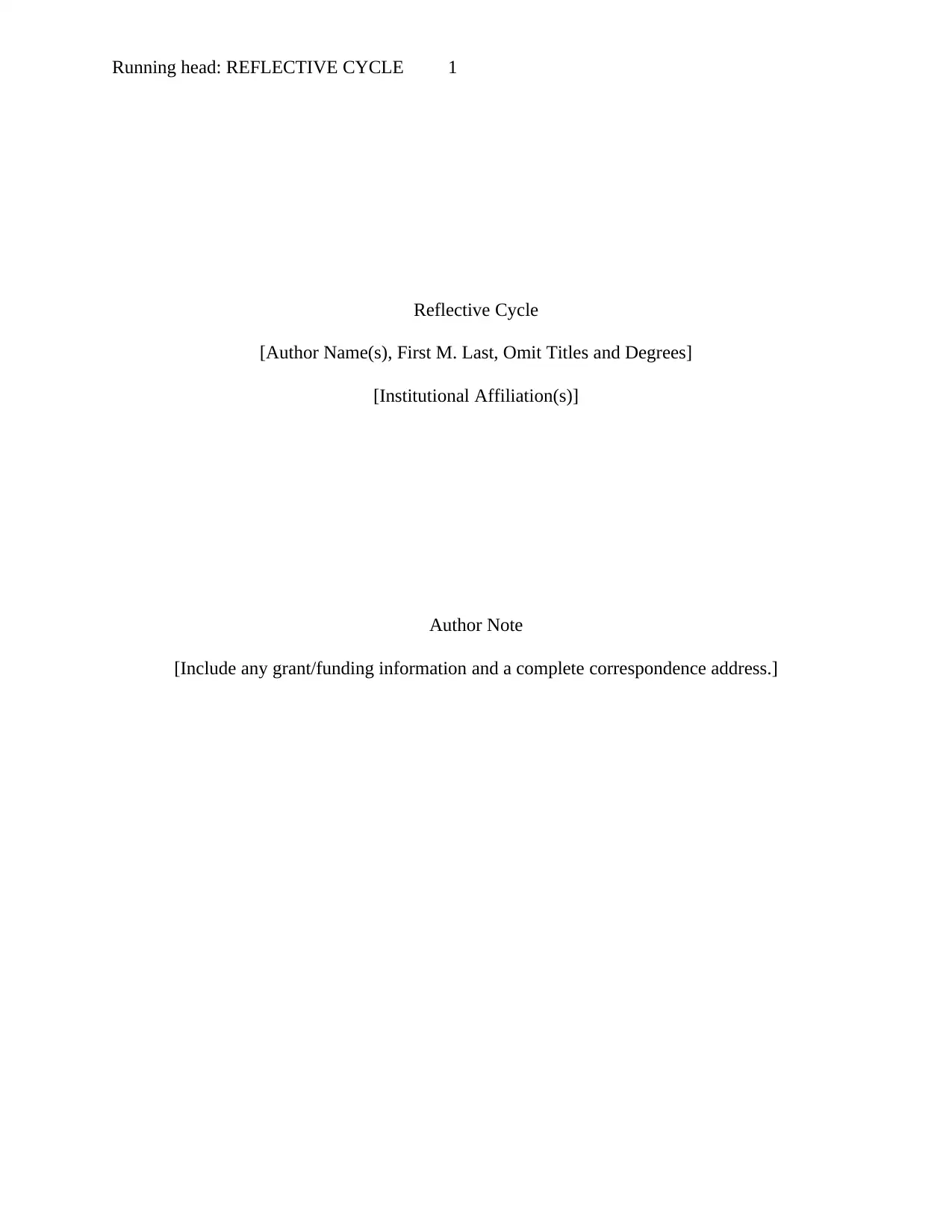
Running head: REFLECTIVE CYCLE 1
Reflective Cycle
[Author Name(s), First M. Last, Omit Titles and Degrees]
[Institutional Affiliation(s)]
Author Note
[Include any grant/funding information and a complete correspondence address.]
Reflective Cycle
[Author Name(s), First M. Last, Omit Titles and Degrees]
[Institutional Affiliation(s)]
Author Note
[Include any grant/funding information and a complete correspondence address.]
Paraphrase This Document
Need a fresh take? Get an instant paraphrase of this document with our AI Paraphraser
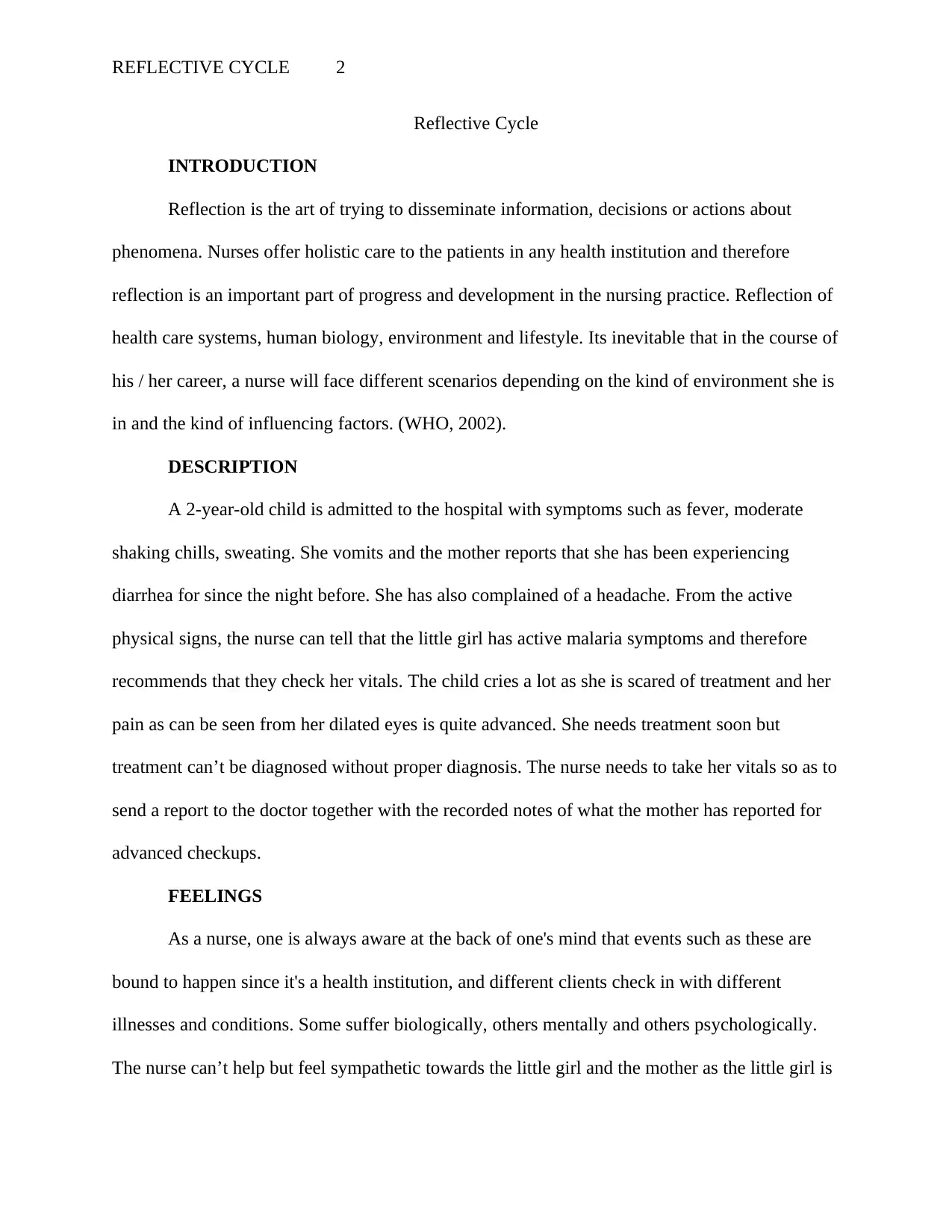
REFLECTIVE CYCLE 2
Reflective Cycle
INTRODUCTION
Reflection is the art of trying to disseminate information, decisions or actions about
phenomena. Nurses offer holistic care to the patients in any health institution and therefore
reflection is an important part of progress and development in the nursing practice. Reflection of
health care systems, human biology, environment and lifestyle. Its inevitable that in the course of
his / her career, a nurse will face different scenarios depending on the kind of environment she is
in and the kind of influencing factors. (WHO, 2002).
DESCRIPTION
A 2-year-old child is admitted to the hospital with symptoms such as fever, moderate
shaking chills, sweating. She vomits and the mother reports that she has been experiencing
diarrhea for since the night before. She has also complained of a headache. From the active
physical signs, the nurse can tell that the little girl has active malaria symptoms and therefore
recommends that they check her vitals. The child cries a lot as she is scared of treatment and her
pain as can be seen from her dilated eyes is quite advanced. She needs treatment soon but
treatment can’t be diagnosed without proper diagnosis. The nurse needs to take her vitals so as to
send a report to the doctor together with the recorded notes of what the mother has reported for
advanced checkups.
FEELINGS
As a nurse, one is always aware at the back of one's mind that events such as these are
bound to happen since it's a health institution, and different clients check in with different
illnesses and conditions. Some suffer biologically, others mentally and others psychologically.
The nurse can’t help but feel sympathetic towards the little girl and the mother as the little girl is
Reflective Cycle
INTRODUCTION
Reflection is the art of trying to disseminate information, decisions or actions about
phenomena. Nurses offer holistic care to the patients in any health institution and therefore
reflection is an important part of progress and development in the nursing practice. Reflection of
health care systems, human biology, environment and lifestyle. Its inevitable that in the course of
his / her career, a nurse will face different scenarios depending on the kind of environment she is
in and the kind of influencing factors. (WHO, 2002).
DESCRIPTION
A 2-year-old child is admitted to the hospital with symptoms such as fever, moderate
shaking chills, sweating. She vomits and the mother reports that she has been experiencing
diarrhea for since the night before. She has also complained of a headache. From the active
physical signs, the nurse can tell that the little girl has active malaria symptoms and therefore
recommends that they check her vitals. The child cries a lot as she is scared of treatment and her
pain as can be seen from her dilated eyes is quite advanced. She needs treatment soon but
treatment can’t be diagnosed without proper diagnosis. The nurse needs to take her vitals so as to
send a report to the doctor together with the recorded notes of what the mother has reported for
advanced checkups.
FEELINGS
As a nurse, one is always aware at the back of one's mind that events such as these are
bound to happen since it's a health institution, and different clients check in with different
illnesses and conditions. Some suffer biologically, others mentally and others psychologically.
The nurse can’t help but feel sympathetic towards the little girl and the mother as the little girl is
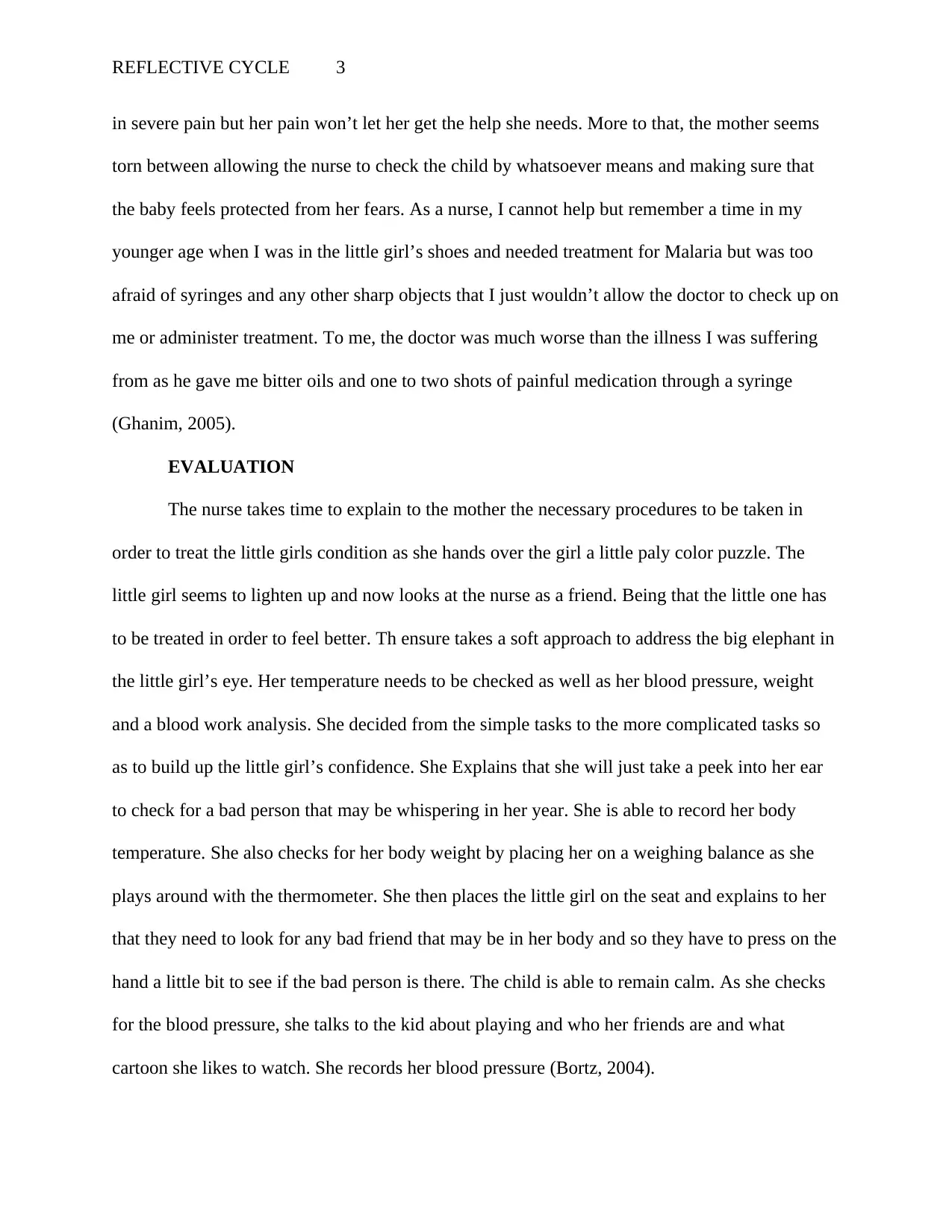
REFLECTIVE CYCLE 3
in severe pain but her pain won’t let her get the help she needs. More to that, the mother seems
torn between allowing the nurse to check the child by whatsoever means and making sure that
the baby feels protected from her fears. As a nurse, I cannot help but remember a time in my
younger age when I was in the little girl’s shoes and needed treatment for Malaria but was too
afraid of syringes and any other sharp objects that I just wouldn’t allow the doctor to check up on
me or administer treatment. To me, the doctor was much worse than the illness I was suffering
from as he gave me bitter oils and one to two shots of painful medication through a syringe
(Ghanim, 2005).
EVALUATION
The nurse takes time to explain to the mother the necessary procedures to be taken in
order to treat the little girls condition as she hands over the girl a little paly color puzzle. The
little girl seems to lighten up and now looks at the nurse as a friend. Being that the little one has
to be treated in order to feel better. Th ensure takes a soft approach to address the big elephant in
the little girl’s eye. Her temperature needs to be checked as well as her blood pressure, weight
and a blood work analysis. She decided from the simple tasks to the more complicated tasks so
as to build up the little girl’s confidence. She Explains that she will just take a peek into her ear
to check for a bad person that may be whispering in her year. She is able to record her body
temperature. She also checks for her body weight by placing her on a weighing balance as she
plays around with the thermometer. She then places the little girl on the seat and explains to her
that they need to look for any bad friend that may be in her body and so they have to press on the
hand a little bit to see if the bad person is there. The child is able to remain calm. As she checks
for the blood pressure, she talks to the kid about playing and who her friends are and what
cartoon she likes to watch. She records her blood pressure (Bortz, 2004).
in severe pain but her pain won’t let her get the help she needs. More to that, the mother seems
torn between allowing the nurse to check the child by whatsoever means and making sure that
the baby feels protected from her fears. As a nurse, I cannot help but remember a time in my
younger age when I was in the little girl’s shoes and needed treatment for Malaria but was too
afraid of syringes and any other sharp objects that I just wouldn’t allow the doctor to check up on
me or administer treatment. To me, the doctor was much worse than the illness I was suffering
from as he gave me bitter oils and one to two shots of painful medication through a syringe
(Ghanim, 2005).
EVALUATION
The nurse takes time to explain to the mother the necessary procedures to be taken in
order to treat the little girls condition as she hands over the girl a little paly color puzzle. The
little girl seems to lighten up and now looks at the nurse as a friend. Being that the little one has
to be treated in order to feel better. Th ensure takes a soft approach to address the big elephant in
the little girl’s eye. Her temperature needs to be checked as well as her blood pressure, weight
and a blood work analysis. She decided from the simple tasks to the more complicated tasks so
as to build up the little girl’s confidence. She Explains that she will just take a peek into her ear
to check for a bad person that may be whispering in her year. She is able to record her body
temperature. She also checks for her body weight by placing her on a weighing balance as she
plays around with the thermometer. She then places the little girl on the seat and explains to her
that they need to look for any bad friend that may be in her body and so they have to press on the
hand a little bit to see if the bad person is there. The child is able to remain calm. As she checks
for the blood pressure, she talks to the kid about playing and who her friends are and what
cartoon she likes to watch. She records her blood pressure (Bortz, 2004).
⊘ This is a preview!⊘
Do you want full access?
Subscribe today to unlock all pages.

Trusted by 1+ million students worldwide
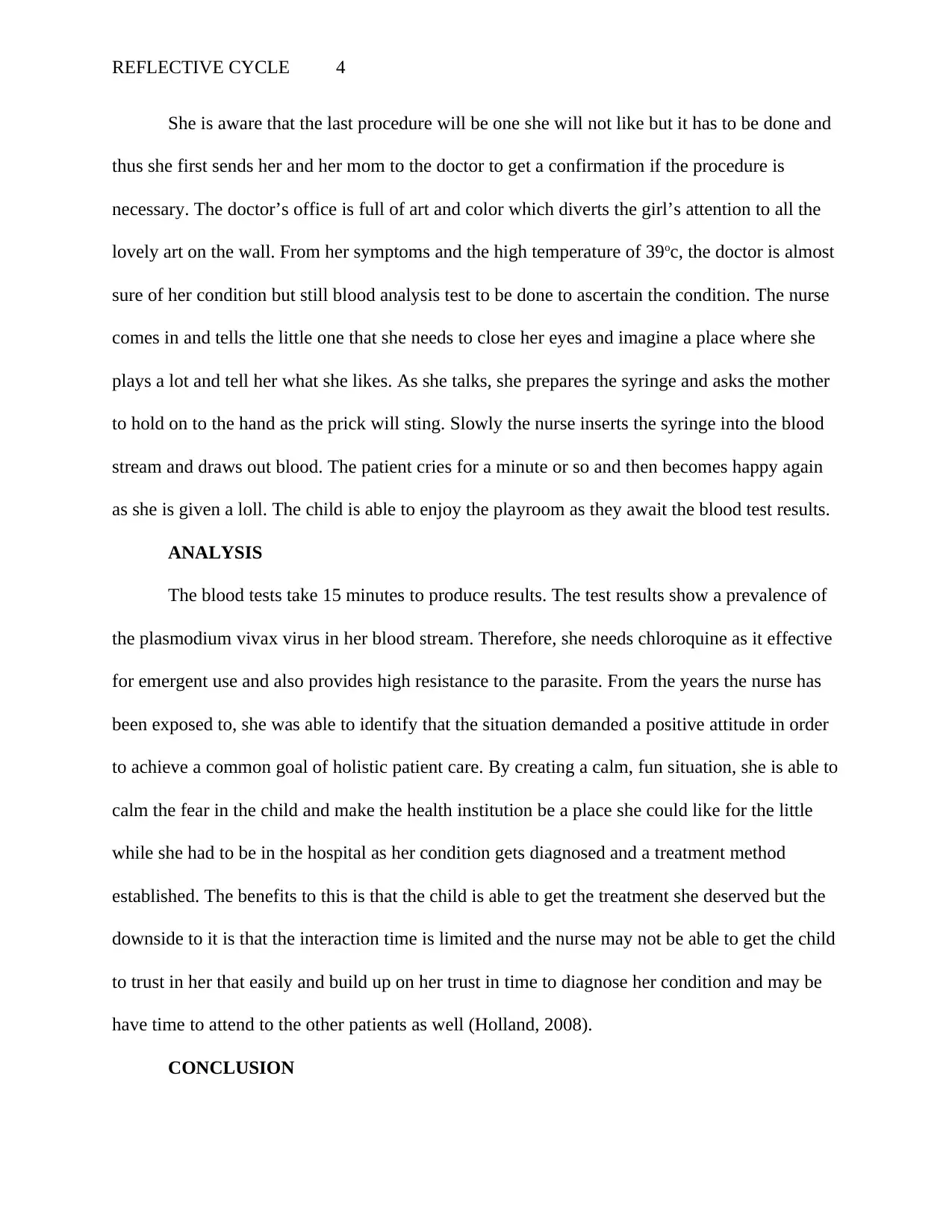
REFLECTIVE CYCLE 4
She is aware that the last procedure will be one she will not like but it has to be done and
thus she first sends her and her mom to the doctor to get a confirmation if the procedure is
necessary. The doctor’s office is full of art and color which diverts the girl’s attention to all the
lovely art on the wall. From her symptoms and the high temperature of 39oc, the doctor is almost
sure of her condition but still blood analysis test to be done to ascertain the condition. The nurse
comes in and tells the little one that she needs to close her eyes and imagine a place where she
plays a lot and tell her what she likes. As she talks, she prepares the syringe and asks the mother
to hold on to the hand as the prick will sting. Slowly the nurse inserts the syringe into the blood
stream and draws out blood. The patient cries for a minute or so and then becomes happy again
as she is given a loll. The child is able to enjoy the playroom as they await the blood test results.
ANALYSIS
The blood tests take 15 minutes to produce results. The test results show a prevalence of
the plasmodium vivax virus in her blood stream. Therefore, she needs chloroquine as it effective
for emergent use and also provides high resistance to the parasite. From the years the nurse has
been exposed to, she was able to identify that the situation demanded a positive attitude in order
to achieve a common goal of holistic patient care. By creating a calm, fun situation, she is able to
calm the fear in the child and make the health institution be a place she could like for the little
while she had to be in the hospital as her condition gets diagnosed and a treatment method
established. The benefits to this is that the child is able to get the treatment she deserved but the
downside to it is that the interaction time is limited and the nurse may not be able to get the child
to trust in her that easily and build up on her trust in time to diagnose her condition and may be
have time to attend to the other patients as well (Holland, 2008).
CONCLUSION
She is aware that the last procedure will be one she will not like but it has to be done and
thus she first sends her and her mom to the doctor to get a confirmation if the procedure is
necessary. The doctor’s office is full of art and color which diverts the girl’s attention to all the
lovely art on the wall. From her symptoms and the high temperature of 39oc, the doctor is almost
sure of her condition but still blood analysis test to be done to ascertain the condition. The nurse
comes in and tells the little one that she needs to close her eyes and imagine a place where she
plays a lot and tell her what she likes. As she talks, she prepares the syringe and asks the mother
to hold on to the hand as the prick will sting. Slowly the nurse inserts the syringe into the blood
stream and draws out blood. The patient cries for a minute or so and then becomes happy again
as she is given a loll. The child is able to enjoy the playroom as they await the blood test results.
ANALYSIS
The blood tests take 15 minutes to produce results. The test results show a prevalence of
the plasmodium vivax virus in her blood stream. Therefore, she needs chloroquine as it effective
for emergent use and also provides high resistance to the parasite. From the years the nurse has
been exposed to, she was able to identify that the situation demanded a positive attitude in order
to achieve a common goal of holistic patient care. By creating a calm, fun situation, she is able to
calm the fear in the child and make the health institution be a place she could like for the little
while she had to be in the hospital as her condition gets diagnosed and a treatment method
established. The benefits to this is that the child is able to get the treatment she deserved but the
downside to it is that the interaction time is limited and the nurse may not be able to get the child
to trust in her that easily and build up on her trust in time to diagnose her condition and may be
have time to attend to the other patients as well (Holland, 2008).
CONCLUSION
Paraphrase This Document
Need a fresh take? Get an instant paraphrase of this document with our AI Paraphraser
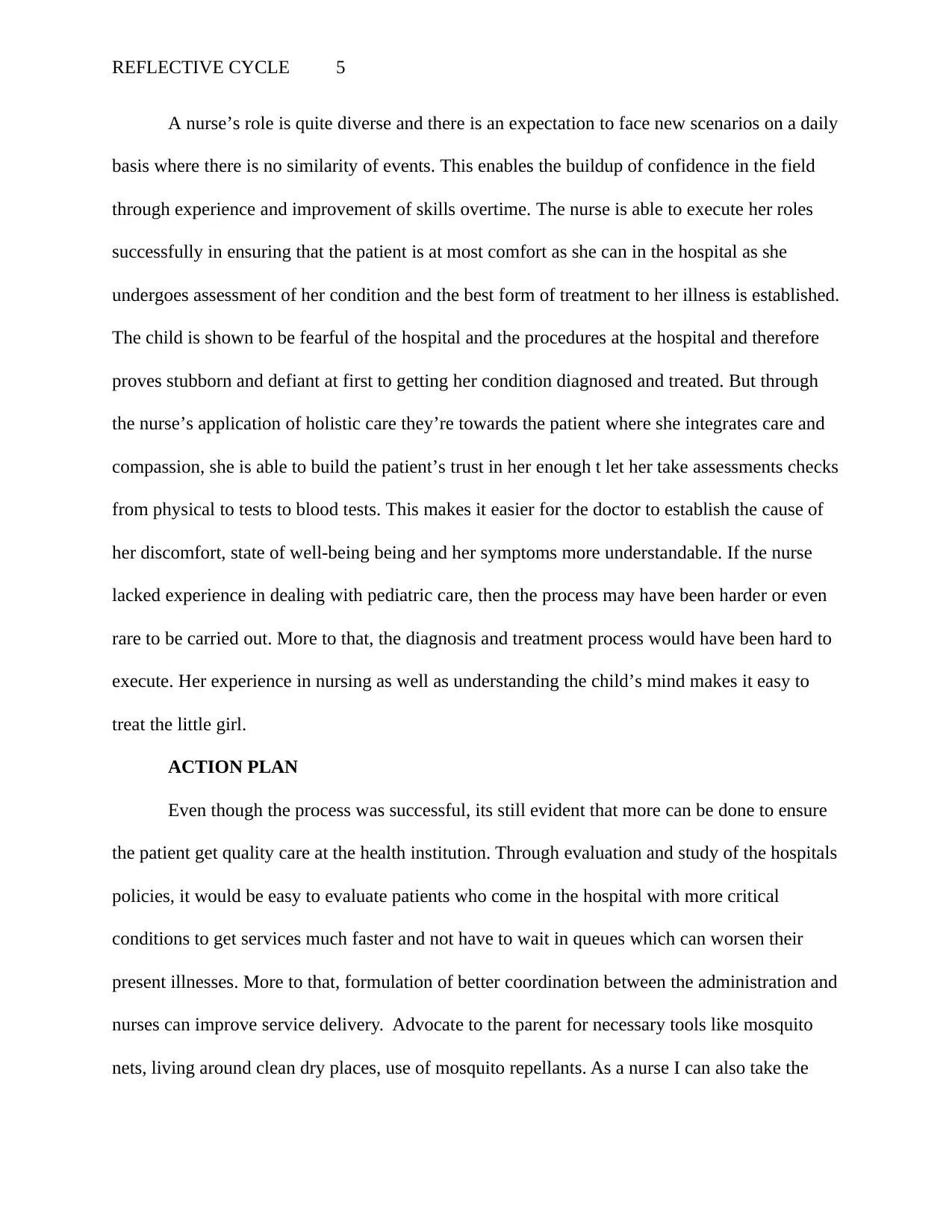
REFLECTIVE CYCLE 5
A nurse’s role is quite diverse and there is an expectation to face new scenarios on a daily
basis where there is no similarity of events. This enables the buildup of confidence in the field
through experience and improvement of skills overtime. The nurse is able to execute her roles
successfully in ensuring that the patient is at most comfort as she can in the hospital as she
undergoes assessment of her condition and the best form of treatment to her illness is established.
The child is shown to be fearful of the hospital and the procedures at the hospital and therefore
proves stubborn and defiant at first to getting her condition diagnosed and treated. But through
the nurse’s application of holistic care they’re towards the patient where she integrates care and
compassion, she is able to build the patient’s trust in her enough t let her take assessments checks
from physical to tests to blood tests. This makes it easier for the doctor to establish the cause of
her discomfort, state of well-being being and her symptoms more understandable. If the nurse
lacked experience in dealing with pediatric care, then the process may have been harder or even
rare to be carried out. More to that, the diagnosis and treatment process would have been hard to
execute. Her experience in nursing as well as understanding the child’s mind makes it easy to
treat the little girl.
ACTION PLAN
Even though the process was successful, its still evident that more can be done to ensure
the patient get quality care at the health institution. Through evaluation and study of the hospitals
policies, it would be easy to evaluate patients who come in the hospital with more critical
conditions to get services much faster and not have to wait in queues which can worsen their
present illnesses. More to that, formulation of better coordination between the administration and
nurses can improve service delivery. Advocate to the parent for necessary tools like mosquito
nets, living around clean dry places, use of mosquito repellants. As a nurse I can also take the
A nurse’s role is quite diverse and there is an expectation to face new scenarios on a daily
basis where there is no similarity of events. This enables the buildup of confidence in the field
through experience and improvement of skills overtime. The nurse is able to execute her roles
successfully in ensuring that the patient is at most comfort as she can in the hospital as she
undergoes assessment of her condition and the best form of treatment to her illness is established.
The child is shown to be fearful of the hospital and the procedures at the hospital and therefore
proves stubborn and defiant at first to getting her condition diagnosed and treated. But through
the nurse’s application of holistic care they’re towards the patient where she integrates care and
compassion, she is able to build the patient’s trust in her enough t let her take assessments checks
from physical to tests to blood tests. This makes it easier for the doctor to establish the cause of
her discomfort, state of well-being being and her symptoms more understandable. If the nurse
lacked experience in dealing with pediatric care, then the process may have been harder or even
rare to be carried out. More to that, the diagnosis and treatment process would have been hard to
execute. Her experience in nursing as well as understanding the child’s mind makes it easy to
treat the little girl.
ACTION PLAN
Even though the process was successful, its still evident that more can be done to ensure
the patient get quality care at the health institution. Through evaluation and study of the hospitals
policies, it would be easy to evaluate patients who come in the hospital with more critical
conditions to get services much faster and not have to wait in queues which can worsen their
present illnesses. More to that, formulation of better coordination between the administration and
nurses can improve service delivery. Advocate to the parent for necessary tools like mosquito
nets, living around clean dry places, use of mosquito repellants. As a nurse I can also take the
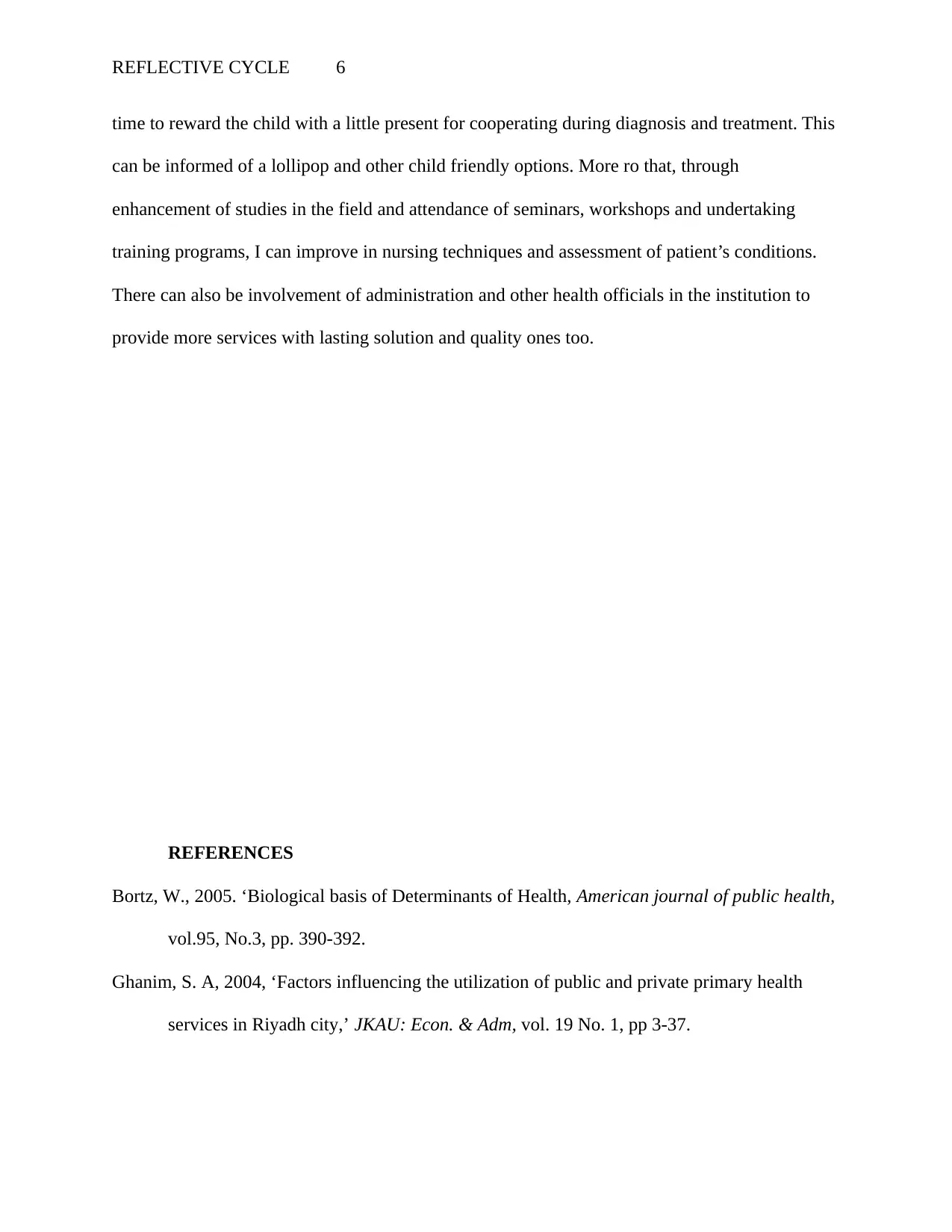
REFLECTIVE CYCLE 6
time to reward the child with a little present for cooperating during diagnosis and treatment. This
can be informed of a lollipop and other child friendly options. More ro that, through
enhancement of studies in the field and attendance of seminars, workshops and undertaking
training programs, I can improve in nursing techniques and assessment of patient’s conditions.
There can also be involvement of administration and other health officials in the institution to
provide more services with lasting solution and quality ones too.
REFERENCES
Bortz, W., 2005. ‘Biological basis of Determinants of Health, American journal of public health,
vol.95, No.3, pp. 390-392.
Ghanim, S. A, 2004, ‘Factors influencing the utilization of public and private primary health
services in Riyadh city,’ JKAU: Econ. & Adm, vol. 19 No. 1, pp 3-37.
time to reward the child with a little present for cooperating during diagnosis and treatment. This
can be informed of a lollipop and other child friendly options. More ro that, through
enhancement of studies in the field and attendance of seminars, workshops and undertaking
training programs, I can improve in nursing techniques and assessment of patient’s conditions.
There can also be involvement of administration and other health officials in the institution to
provide more services with lasting solution and quality ones too.
REFERENCES
Bortz, W., 2005. ‘Biological basis of Determinants of Health, American journal of public health,
vol.95, No.3, pp. 390-392.
Ghanim, S. A, 2004, ‘Factors influencing the utilization of public and private primary health
services in Riyadh city,’ JKAU: Econ. & Adm, vol. 19 No. 1, pp 3-37.
⊘ This is a preview!⊘
Do you want full access?
Subscribe today to unlock all pages.

Trusted by 1+ million students worldwide
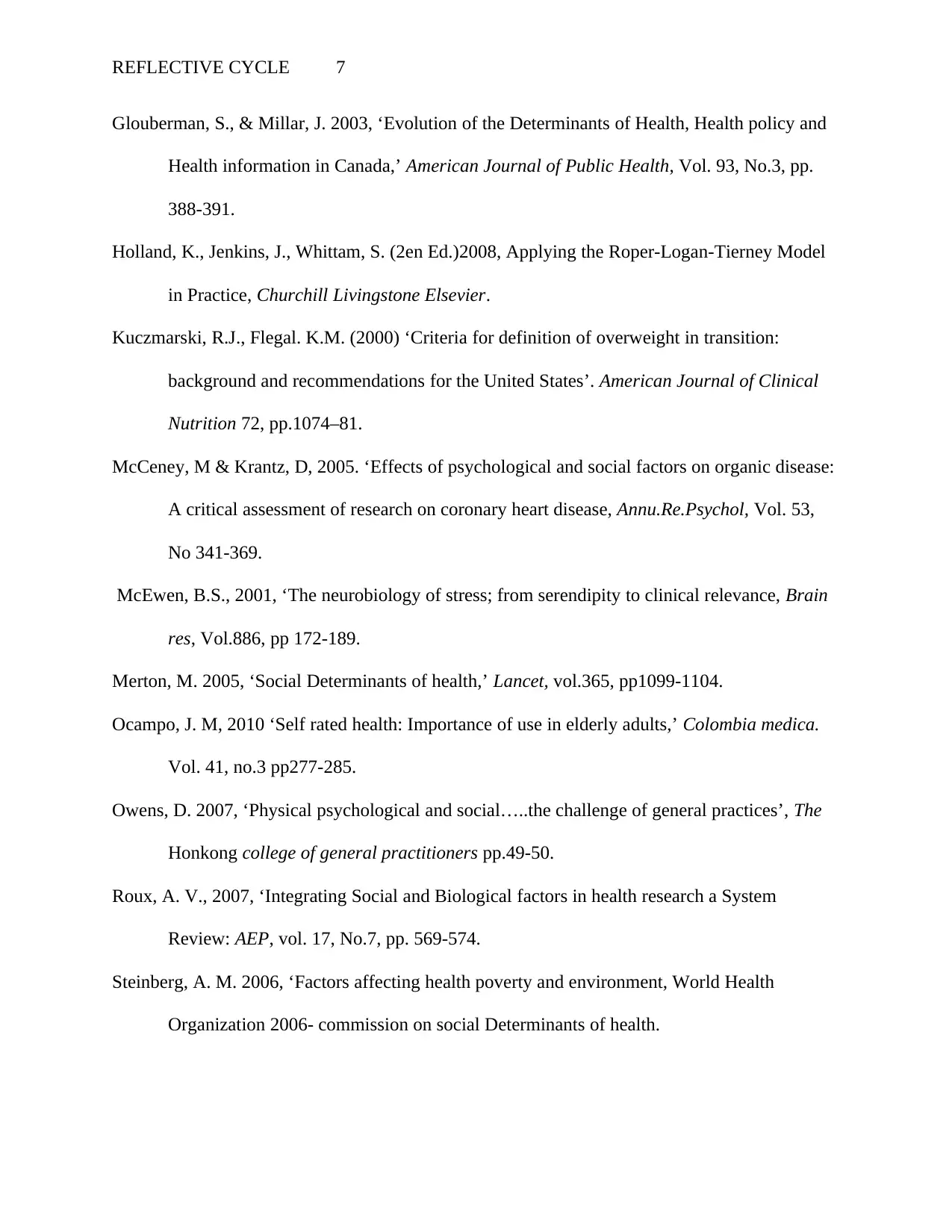
REFLECTIVE CYCLE 7
Glouberman, S., & Millar, J. 2003, ‘Evolution of the Determinants of Health, Health policy and
Health information in Canada,’ American Journal of Public Health, Vol. 93, No.3, pp.
388-391.
Holland, K., Jenkins, J., Whittam, S. (2en Ed.)2008, Applying the Roper-Logan-Tierney Model
in Practice, Churchill Livingstone Elsevier.
Kuczmarski, R.J., Flegal. K.M. (2000) ‘Criteria for definition of overweight in transition:
background and recommendations for the United States’. American Journal of Clinical
Nutrition 72, pp.1074–81.
McCeney, M & Krantz, D, 2005. ‘Effects of psychological and social factors on organic disease:
A critical assessment of research on coronary heart disease, Annu.Re.Psychol, Vol. 53,
No 341-369.
McEwen, B.S., 2001, ‘The neurobiology of stress; from serendipity to clinical relevance, Brain
res, Vol.886, pp 172-189.
Merton, M. 2005, ‘Social Determinants of health,’ Lancet, vol.365, pp1099-1104.
Ocampo, J. M, 2010 ‘Self rated health: Importance of use in elderly adults,’ Colombia medica.
Vol. 41, no.3 pp277-285.
Owens, D. 2007, ‘Physical psychological and social…..the challenge of general practices’, The
Honkong college of general practitioners pp.49-50.
Roux, A. V., 2007, ‘Integrating Social and Biological factors in health research a System
Review: AEP, vol. 17, No.7, pp. 569-574.
Steinberg, A. M. 2006, ‘Factors affecting health poverty and environment, World Health
Organization 2006- commission on social Determinants of health.
Glouberman, S., & Millar, J. 2003, ‘Evolution of the Determinants of Health, Health policy and
Health information in Canada,’ American Journal of Public Health, Vol. 93, No.3, pp.
388-391.
Holland, K., Jenkins, J., Whittam, S. (2en Ed.)2008, Applying the Roper-Logan-Tierney Model
in Practice, Churchill Livingstone Elsevier.
Kuczmarski, R.J., Flegal. K.M. (2000) ‘Criteria for definition of overweight in transition:
background and recommendations for the United States’. American Journal of Clinical
Nutrition 72, pp.1074–81.
McCeney, M & Krantz, D, 2005. ‘Effects of psychological and social factors on organic disease:
A critical assessment of research on coronary heart disease, Annu.Re.Psychol, Vol. 53,
No 341-369.
McEwen, B.S., 2001, ‘The neurobiology of stress; from serendipity to clinical relevance, Brain
res, Vol.886, pp 172-189.
Merton, M. 2005, ‘Social Determinants of health,’ Lancet, vol.365, pp1099-1104.
Ocampo, J. M, 2010 ‘Self rated health: Importance of use in elderly adults,’ Colombia medica.
Vol. 41, no.3 pp277-285.
Owens, D. 2007, ‘Physical psychological and social…..the challenge of general practices’, The
Honkong college of general practitioners pp.49-50.
Roux, A. V., 2007, ‘Integrating Social and Biological factors in health research a System
Review: AEP, vol. 17, No.7, pp. 569-574.
Steinberg, A. M. 2006, ‘Factors affecting health poverty and environment, World Health
Organization 2006- commission on social Determinants of health.
Paraphrase This Document
Need a fresh take? Get an instant paraphrase of this document with our AI Paraphraser
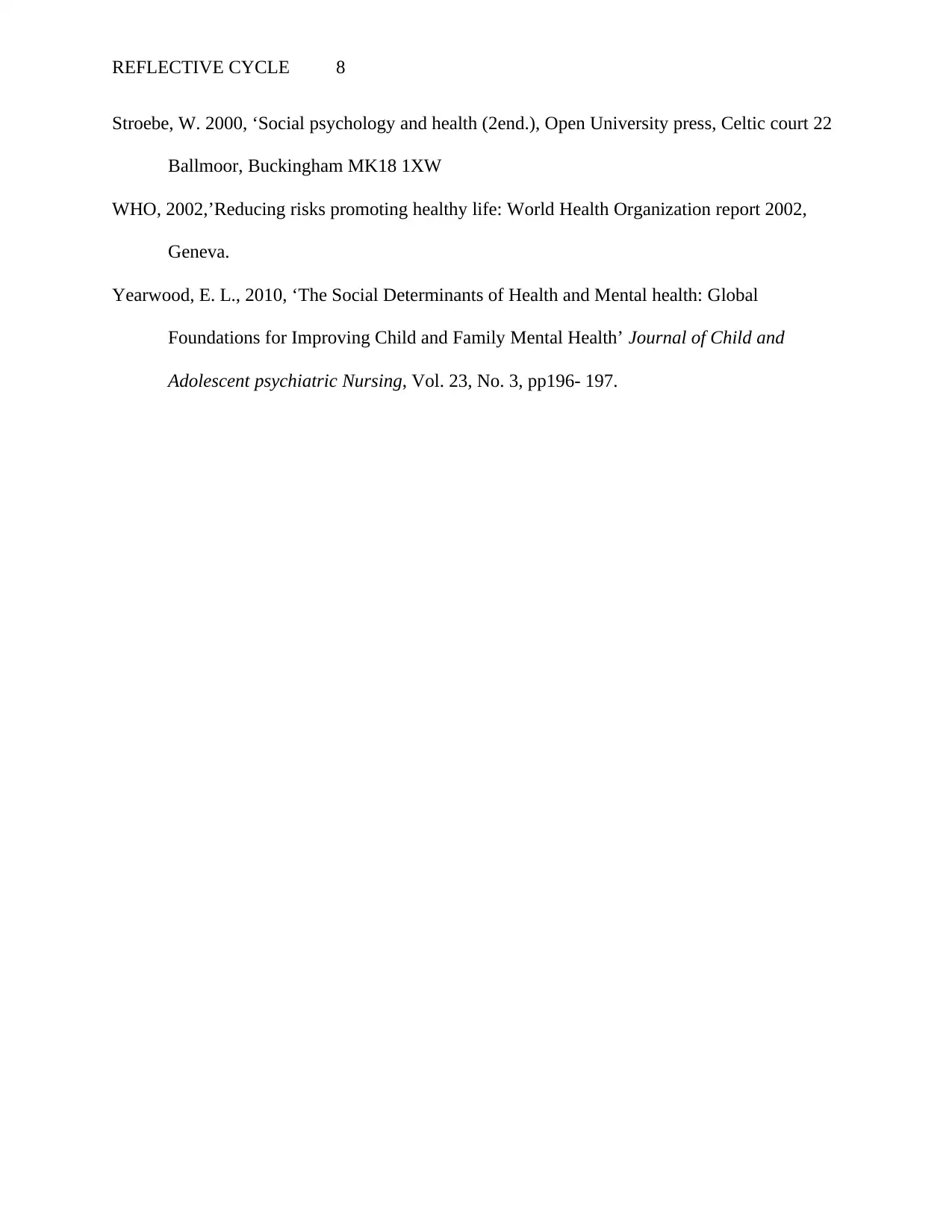
REFLECTIVE CYCLE 8
Stroebe, W. 2000, ‘Social psychology and health (2end.), Open University press, Celtic court 22
Ballmoor, Buckingham MK18 1XW
WHO, 2002,’Reducing risks promoting healthy life: World Health Organization report 2002,
Geneva.
Yearwood, E. L., 2010, ‘The Social Determinants of Health and Mental health: Global
Foundations for Improving Child and Family Mental Health’ Journal of Child and
Adolescent psychiatric Nursing, Vol. 23, No. 3, pp196- 197.
Stroebe, W. 2000, ‘Social psychology and health (2end.), Open University press, Celtic court 22
Ballmoor, Buckingham MK18 1XW
WHO, 2002,’Reducing risks promoting healthy life: World Health Organization report 2002,
Geneva.
Yearwood, E. L., 2010, ‘The Social Determinants of Health and Mental health: Global
Foundations for Improving Child and Family Mental Health’ Journal of Child and
Adolescent psychiatric Nursing, Vol. 23, No. 3, pp196- 197.
1 out of 8
Related Documents
Your All-in-One AI-Powered Toolkit for Academic Success.
+13062052269
info@desklib.com
Available 24*7 on WhatsApp / Email
![[object Object]](/_next/static/media/star-bottom.7253800d.svg)
Unlock your academic potential
© 2024 | Zucol Services PVT LTD | All rights reserved.




